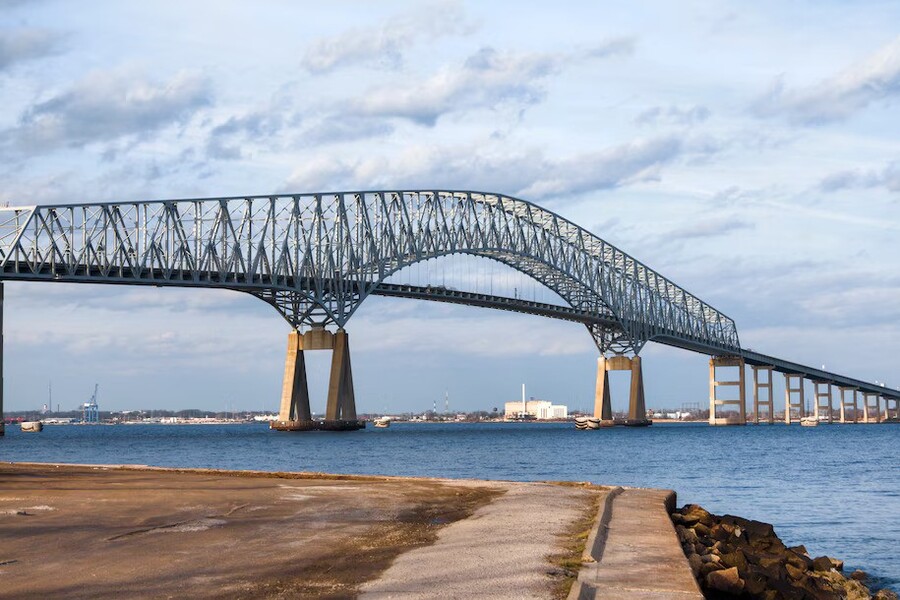In the early hours of a seemingly ordinary Tuesday, the Francis Scott Key Bridge, a vital artery for Baltimore’s commuters and an iconic silhouette against the Patapsco River’s backdrop, was struck by a catastrophic event. The Dali, a cargo ship of formidable size at 985 feet long, owned by Grace Ocean Private Ltd. and flying under Singapore’s flag, experienced a critical failure, losing power and careening uncontrollably towards the bridge. Despite desperate mayday calls signaling the impending disaster, the ship’s velocity remained unchecked, leading to a collision that would reverberate through the community and beyond.
As the ship struck the bridge’s support, the structure succumbed, segments of it collapsing into the water below within moments. The bridge, stretching 1.6 miles and not just a vehicle conduit but a lifeline for the local economy and a daily route for countless individuals, was rendered a scene of devastation. Emergency services’ dispatch audio captured the immediate aftermath: urgent calls for dive teams, reports of construction workers now feared in the water, and the grim acknowledgment of what was quickly becoming a “mass casualty” incident.
Emergency Response and Heroism
The first responders’ efforts were monumental, navigating the chaos to rescue two individuals and search for six missing construction workers, presumed dead. Their dedication in the face of such tragedy highlights the broader community’s resilience and the critical role of emergency services in disaster response. The dispatch recordings offer a window into the tense atmosphere of those initial hours, underscoring the human element at the disaster’s heart.
Federal Response and Rebuilding Efforts
President Joe Biden’s immediate declaration that the federal government would fully fund the bridge’s reconstruction underscores the national significance of the incident. Leveraging resources from the Federal Highway Administration and the Bipartisan Infrastructure Law, Biden’s commitment aims to bypass bureaucratic hurdles and ensure a swift restoration of this critical infrastructure piece. This federal pledge, sidelining lengthy debates over financial responsibilities, especially concerning the vessel’s ownership, emphasizes the urgency of restoring the logistical and economic conduit the bridge represents.
Engineering Insights and Infrastructure Resilience
The disaster has spurred a vigorous debate among engineering experts and transportation authorities regarding infrastructure resilience. Dr. Erin Bell’s comparison of the Key Bridge’s truss design with the cantilever truss structure of Boston’s Tobin Bridge elucidates the technical aspects influencing the disaster’s outcome. The through truss design, while historically significant, proved disastrously inadequate against the unexpected force, leading to the bridge’s total collapse. This has ignited conversations on the necessity for design evolution and maintenance practices that can better withstand modern challenges, including increased maritime traffic and environmental threats.
Economic and Community Impact
The bridge’s collapse not only disrupts daily commutes but also has significant economic repercussions for Baltimore and the surrounding region. The disruption of traffic flow impacts local businesses, supply chains, and the broader economic activities dependent on this critical infrastructure. The federal commitment to rebuild is a recognition of these stakes, emphasizing the need to restore normalcy and economic stability as swiftly as possible.
Long-Term Implications and Lessons Learned
Beyond the immediate rescue and rebuilding efforts, the Francis Scott Key Bridge collapse serves as a poignant reminder of the vulnerabilities in our nation’s infrastructure. It challenges us to reassess how we conceive, construct, and maintain the frameworks that underpin our daily lives. This incident, though marked by loss and destruction, may catalyze a new era of infrastructure development, one that prioritizes safety, resilience, and innovation.
The conversation sparked by this tragedy encompasses the technical aspects of bridge design and the broader implications for infrastructure policy, emergency preparedness, and community resilience. As the nation reflects on this event, it becomes a pivotal moment for advocating more robust, sustainable infrastructure solutions that can endure the challenges of the 21st century and beyond.
The collapse of the Francis Scott Key Bridge is more than a local tragedy; it is a national moment of reckoning on the state of our infrastructure, the necessity of emergency preparedness, and the importance of federal involvement in disaster response and recovery. As investigations proceed and plans for reconstruction take shape, this incident stands as a stark reminder of the need for continuous investment in and reevaluation of our infrastructure. Through this tragedy, new pathways for innovation in design and construction may emerge, ensuring that future generations inherit safer, more resilient, and more sustainable infrastructure.





















